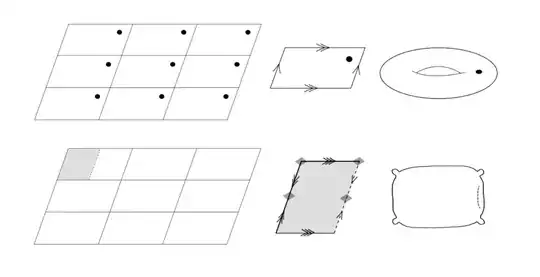the hexagon with opposite sides identifies can be seen as the plane "quotiented" by some equivalence relation. But can it be seen as the quotient of two groups?
Yes. Let $H$ be a subgroup of $\Bbb R^2$ consisting of elements $x$ such that a translation of $\Bbb R^2$ by $x$ keeps a given regular hexagonal lattice. The group $H$ is generated by three translations by one cell, whose sum is the identity map. That is, in fact, $H$ is generated by any two of these translations and $H$ is isomorphic to $\Bbb Z^2$. A quotient topological group $\Bbb R^2/H$ is homeomorphic to a hexagonal cell of the lattice with the opposite sides identified, that is a torus again.
Can we consider a different quotient in which in the numerator $\Bbb R^2$ is replaced by the whole 2D Euclidian group, and in the denominator $\Bbb Z^2$ is replaced by the whole symmmetry group of the square lattice? What do we get?
I suppose that by the whole 2D Euclidian group you mean the group $G$ of isometries of $\Bbb R^2$. Let $H$ be the group of the elements of $G$ preserving the lattice $\Bbb Z^2$. For our purpose it is convenient to consider elements of $G$ in terms of complex numbers. In the description in terms of $a$ and $\omega$, the elements of $H$ are exactly those with $a\in\Bbb Z^2$ and $\omega\in \{1,-1,i,-i\}$. Since $H$ contains a map $\bar z$, each coset $fH$ of $G/H$ intersects both $G_+$ and $G\setminus G_+$, where $G_+$ consists of maps $z\mapsto a+\omega z$. So we shall study the quotient set $G_+/H_+$, where $H_+=G_+\cap H$.
The group $G_+$ can be identified with the set of pairs $(a,\omega)$, where $a\in\Bbb C$, $\omega\in\Bbb T$, and $\Bbb T=\{z\in\Bbb C:|z|=1\}$. This identification imposes on $G_+$ a topology of a subset of $\Bbb C^2$. Remark that the identification imposes on $\Bbb C\times \Bbb T$ an operation $(a,\omega) (a’,\omega’)=(a’+\omega’ a, \omega\omega’)$ for any $a,a’\in\Bbb C$ and $\omega,\omega’\in\Bbb T$. Taking representatives, we see that $G_+/H_+$ is homeomorphic to a cube $[0,1]^3$ with some identifications of its boundary points. Namely, for each $x,y,z\in [0,1]$, $(0,y,z)\sim (1,y,z)$, $(x,0,z)\sim (x,1, z)$, and $(x,y,0)\sim (y,x,1)$. This is a torus, whose surface we inflated a bit, and then we put it into a high-dimensional space and glue its outer surface with the inner, swapping parallels with meridians.

